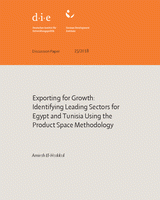Exporting for growth: identifying leading sectors for Egypt and Tunisia using the Product Space Methodology
El-Haddad, AmirahDiscussion Paper 25/2018
Bonn: German Development Institute / Deutsches Institut für Entwicklungspolitik (DIE)
ISBN: 978-3-96021-075-7
DOI: https://doi.org/10.23661/dp25.2018
Preis: 6 €
Arabic version:
at-Taṣdīr min aǧli n-numūw: taḥdīd al-qiṭāʿāt ar-rāʾida fī Miṣr wa-Tūnis bi-ʾstiḫdām manhaǧīya qaḍāʾ al-muntaǧāt
(Discussion Paper 5/2019)
The structural transformation of countries moves them towards more sophisticated, higher-value products. Network analysis, using the Product Space Methodology (PSM), guides countries towards leading export sectors. The identification process rests on two pillars: (1) available opportunities, that is, products in the product space that the country does not yet export which are more sophisticated than its current exports; and (2) the stock of a country’s accumulated productive knowledge and the technical capabilities that, through spillovers, enable it to produce slightly more sophisticated products. The PSM points to a tradeoff between capabilities and complexity. The methodology identifies very basic future products that match the two countries’ equally basic capabilities. Top products are simple animal products, cream and yogurt, modestly sophisticated plastics, metals and minerals such as salt and sulphur for Egypt; and slightly more sophisticated products such as containers and bobbins (plastics) and broom handles and wooden products for Tunisia, which is the more advanced of the two countries. A more interventionist approach steers the economy towards maximum sophistication, thus identifying highly complex manufactured metals, machinery, equipment, electronics and chemicals. Despite pushing for economic growth and diversification, these sectors push urban job creation and require high-skill workers, with the implication that low-skilled labour may be pushed into unemployment or into low-value informal jobs. A middle ground is a forward-looking strategy that takes sectors’ shares in world trade into account. This approach identifies medicaments in the chemicals sector; seats (e.g. car and aeroplane seats) in the “other highly manufactured” sector; inflated rubber tyres in the chemicals community (plastics and rubber); containers, bobbins and packages of plastics also in the plastics and rubber section; and articles of iron and steel in the metals sector for Egypt. The top product for Tunisia is furniture in the highly manufactured and special purpose goods community, followed by three products in plastics and rubber in the chemicals community, and finally three machinery sectors.


